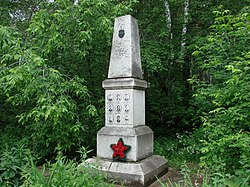 The group's tomb at the Mikhailovskoe Cemetery in Yekaterinburg, Russia, in 2012 | |
| Native name | Гибель тургруппы Дятлова |
|---|---|
| Date | 1–2 February 1959 |
| Location | Kholat Syakhl, Northern Urals, Russian SFSR, Soviet Union |
| Coordinates | 61°45′16″N 59°26′42″E / 61.75444°N 59.44500°E |
| Type | 9 deaths |
| Cause | Physical trauma and hypothermia |
| Outcome | Area closed for 3 years |
| Deaths | 9 trekkers from the Ural Polytechnical Institute
|
The Dyatlov Pass incident (Russian: Гибель тургруппы Дятлова, romanized: Gibel turgruppy Dyatlova, lit. 'Death of the Dyatlov Hiking Group') is an event in which nine Soviet hikers died in the northern Ural Mountains between February 1 and 2, 1959, under uncertain circumstances. The experienced trekking group from the Ural Polytechnical Institute, led by Igor Dyatlov, had established a camp on the eastern slopes of Kholat Syakhl in the Russian SFSR of the Soviet Union. Overnight, something caused them to cut their way out of their tent and flee the campsite while inadequately dressed for the heavy snowfall and subzero temperatures.
After the group's bodies were discovered, an investigation by Soviet authorities determined that six of them had died from hypothermia while the other three had been killed by physical trauma. One victim had major skull damage, two had severe chest trauma, and another had a small crack in his skull. Four of the bodies were found lying in running water in a creek, and three of these four had damaged soft tissue of the head and face – two of the bodies had missing eyes, one had a missing tongue, and one had missing eyebrows. The investigation concluded that a "compelling natural force" had caused the deaths. Numerous theories have been put forward to account for the unexplained deaths, including animal attacks, hypothermia, an avalanche, katabatic winds, infrasound-induced panic, military involvement, or some combination of these factors.
Russia opened a new investigation into the incident in 2019, and its conclusions were presented in July 2020: that an avalanche had led to the deaths. Survivors of the avalanche had been forced to suddenly leave their camp in low-visibility conditions with inadequate clothing and had died of hypothermia. Andrey Kuryakov, deputy head of the regional prosecutor's office, said, "It was a heroic struggle. There was no panic. But they had no chance to save themselves under the circumstances."[1] A study led by scientists from EPFL and ETH Zürich, published in 2021, suggested that a type of avalanche known as a slab avalanche could explain some of the trekkers' injuries.[2][3]
A mountain pass in the area was later named "Dyatlov Pass" in memory of the group. In many languages, the incident is now referred to as the "Dyatlov Pass incident". However, the incident occurred about 1,700 metres (5,600 ft) away, on the eastern slope of Kholat Syakhl.[2] A prominent rock outcrop in the area now serves as a memorial to the group. It is located about 500 metres (1,600 ft) to the east-southeast of the actual site of the final camp.
- ^ Devitt, Polina (11 July 2020). "Russia blames avalanche for 1959 Urals mountain tragedy, RIA agency reports". Reuters. Archived from the original on 13 January 2021. Retrieved 12 September 2020.
- ^ a b Cite error: The named reference
nature-avawas invoked but never defined (see the help page). - ^ Ferreira, Becky (28 January 2021). "Best theory yet for the Dyatlov Pass incident". Vice. Archived from the original on 31 January 2021. Retrieved 3 February 2021.